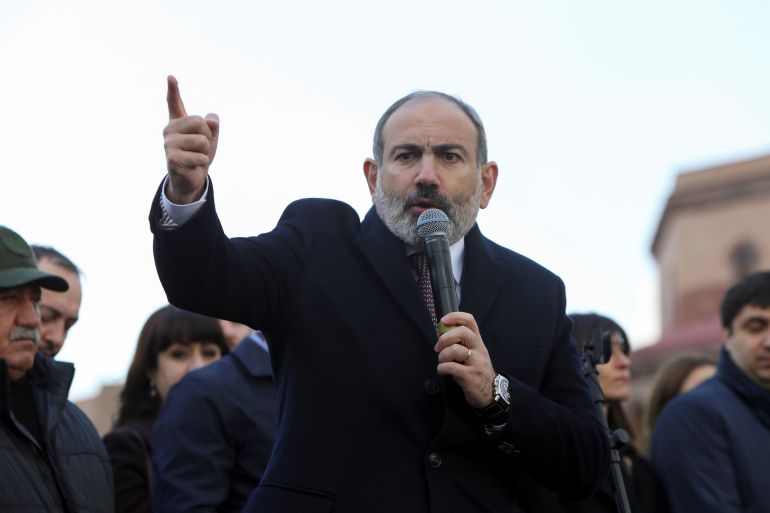Nikol Pashinyan: From street protester to embattled Armenian PM
Pashinyan has faced calls to quit from critics angered by his handling of last year’s Nagorno-Karabakh conflict.

Armenian Prime Minister Nikol Pashinyan finds himself at the centre of a political crisis after the army demanded he resign, a move he said looked like an attempted military coup.
Here are some highlights from the 45-year-old’s rise to power and the challenges he has faced in his post:
Keep reading
list of 4 itemsArmenia PM warns of coup attempt after army seeks his resignation
Nagorno-Karabakh: Armenia, Azerbaijan ‘violated laws of war’
Nagorno-Karabakh: Russia’s Putin hosts Azeri, Armenian leaders
Rise to Power
Pashinyan emerged as the leader of a wave of anti-government street protests that rocked Armenia in the spring of 2018.
Initially prompted by the election of former President Serzh Sargsyan as prime minister, the protests quickly began targeting the government’s perceived political cronyism.
Pashinyan, a former journalist and legislator, nurtured his image as a politician close to the people, wearing casual clothes and a baseball cap at protests to clash with the formal suits worn by members of the ruling Republican Party.
The rallies, sometimes referred to as Armenia’s Velvet Revolution, forced Sargsyan to resign. Opposition parties then united around Pashinyan to vote him in as prime minister despite resistance from the ruling party.
Reforms and challenges
Pashinyan pledged sweeping reforms to revamp the South Caucasus country’s economy and fight corruption, earning him vast popular support. He fired members of the former political elite and prosecuted former officials for alleged embezzlement.
In December 2018, Pashinyan’s My Step Alliance emphatically won snap parliamentary elections that confirmed his popularity.
Despite support for his reforms, Pashinyan has faced criticism from some members of the military apparatus for allegedly being too soft on certain issues.
His opponents have criticised him for not having done his military service. Some even suggested the trademark camouflage T-shirt Pashinyan wore at street protests was meant to compensate for not having served.
Days after Pashinyan took office, clashes between Armenian and Azeri troops erupted on Armenia’s border with Azerbaijan’s exclave of Nakhchivan. The clashes were short-lived, but Pashinyan’s detractors criticised him for not having responded more aggressively.
Nagorno-Karabakh conflict
Pashinyan’s political woes spiralled when he agreed last November to a Russian-brokered ceasefire to end six weeks of fighting between ethnic Armenian and Azeri forces over the region of Nagorno-Karabakh.
The deal that ended the heaviest fighting in the region since the 1990s secured significant territorial gains for Azerbaijan in and around Nagorno-Karabakh, an enclave internationally recognised as part of Azerbaijan but populated and until recently, fully controlled by ethnic Armenians.
Pashinyan said he had been compelled to agree to the peace deal to prevent greater human and territorial losses. The agreement – celebrated as a victory in Azerbaijan – prompted angry crowds to storm government buildings in the Armenian capital, Yerevan.
Calls for Pashinyan to resign have grown exponentially since the deal, which many Armenians have branded a betrayal.